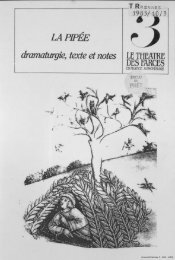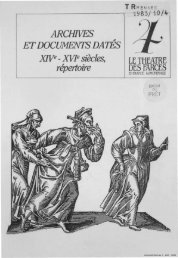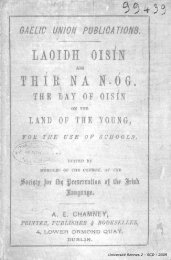The poems of Ossian : vol. 1 - Index of - Université Rennes 2
The poems of Ossian : vol. 1 - Index of - Université Rennes 2
The poems of Ossian : vol. 1 - Index of - Université Rennes 2
You also want an ePaper? Increase the reach of your titles
YUMPU automatically turns print PDFs into web optimized ePapers that Google loves.
xl<br />
l<br />
<strong>The</strong> seventh<br />
Duan <strong>of</strong><br />
"Temora " appears<br />
to have<br />
been copied<br />
from sorne<br />
ancient .1lIS.<br />
DISSERTATlüX.<br />
will not enlarge on it here, but merely observe that there is a<br />
remarkable absence <strong>of</strong> secondary or subsidiary words, <strong>of</strong> pronouns,<br />
prepositions; and conjunctions; that generally, instead <strong>of</strong> an<br />
adjective qualifying a nOUTI, we have two nouns in regimen; that<br />
the same word is used in an extraordinary variety <strong>of</strong> different<br />
meanings- homonymy, as linguists calI it ; · and that there is<br />
an almost utter disregard <strong>of</strong> infiections, whether <strong>of</strong> nouns or <strong>of</strong><br />
verbs, as there is also <strong>of</strong> the present order <strong>of</strong> syntax. I am quite<br />
aware that at a certain early period in the history <strong>of</strong> language,<br />
before "phonetic decay " has made many ravages on it, infiections<br />
are much more abundant than at a later stage, when the friction<br />
<strong>of</strong> lonz-continued e<br />
use has worn down an its distinctive marks.<br />
But there is a period older th an this still, " when language knows<br />
no inflections ;" 1- and th e language <strong>of</strong> <strong>Ossian</strong> seems to me clearly<br />
to belong to such a period as this. :j:<br />
Unfortunately nothing can be deduced from the spelling <strong>of</strong><br />
th ese <strong>poems</strong>, as they were modernised before being published,<br />
and we have not even Macpherson's own transcript <strong>of</strong>theru. <strong>The</strong><br />
only specimens <strong>of</strong> his Gaelic which, as far as I kn ow, remain to<br />
us are the seventh book <strong>of</strong> "Temora," which he pnblished at the<br />
end <strong>of</strong> his Collection in 1763, and a portion <strong>of</strong> " Carric-th ura,'<br />
given in High. Soc. Rep. <strong>The</strong> orthography <strong>of</strong> the seventh book<br />
<strong>of</strong> " Temora " is different from any other Gaelic which I have met<br />
with ; and there are two peculiarities belonging to it ...vhich I<br />
wonld briefly point out :-<br />
1. <strong>The</strong>re is a "destitutio tenuium" - the hard consonants<br />
C, p, t, are used where the s<strong>of</strong>t ones g, b, d, are now written; and<br />
let it be remembered that this use <strong>of</strong> the hard instead <strong>of</strong> the s<strong>of</strong>t<br />
* :My attempts to explain this variety in regard ta such words as cli, tuar, and<br />
many more, compel me to such repetition in my sidenotes as must be wearisome<br />
to the reader.<br />
.t Pr<strong>of</strong>essor M. Müller's Science <strong>of</strong> Languages, second seri es, p. 84.87.<br />
::: It has been objected to <strong>Ossian</strong> that he frequently places the adj ective before<br />
the substantive, in entire opposition to modern Gaelic usage. L àn-bhrodleach<br />
oiyh, &c., has been called bad Gaelic. I notice, however, in the few Gaelic<br />
entries <strong>of</strong> the' Book <strong>of</strong> Deer,' written in the eleventh and twelfth centuries, th at<br />
this disp osition <strong>of</strong> noun and adjective frequently occurs. <strong>The</strong> modern maor-môr is<br />
uniformly written m01·-maor. At the same time I am sorry t o observe th at the<br />
remarkable looseness which is still a reproach to Gaelic orthography dat es as<br />
far back as the days <strong>of</strong> the clerics <strong>of</strong> Deer, who, in the same sentence, use two<br />
or three spellings <strong>of</strong> the same word.<br />
consonants is the test wliich Zeuss has applied to determ ine the<br />
age <strong>of</strong> Celtic writings.<br />
2. <strong>The</strong>re is a very troublesome rule laid down by Irish grammarians<br />
as to the harmony <strong>of</strong> vowels, enjoining that if the last<br />
vowel in a syllable be bread, the first vowel in the next syllable<br />
must be so also, and vice versa. Pr<strong>of</strong>essor M. Müller states that<br />
the same rule is followed in Tnrkish, and in some other languages<br />
<strong>of</strong> the Turanian family ; but it seems to be unknown in any<br />
Aryan language except the Gaelic, as it is wholly unknown<br />
in Semitic. <strong>The</strong> writers <strong>of</strong> Scottish Gaelic have frequently<br />
prot ested against it; but aIl modern Gaelic observes it, neverth<br />
eless. Now this rul e is disregarded in the seventh Duan <strong>of</strong><br />
" Temora," while it is followed in other writings <strong>of</strong> the same period,<br />
and in the specimen <strong>of</strong> " Carric-th ura" by Macpherson. Strathmashie<br />
gets th e credit <strong>of</strong> writing this book, and is frequently used<br />
as the" deus ex machina "-the good fairy to solve difficulties by<br />
those who adopt a theory <strong>of</strong> compromise in regard to the authorship,<br />
a th eory very characteristic <strong>of</strong> the spirit <strong>of</strong> the present day.<br />
H ere, however, apart altozether 0 from his own distinct testimouy,<br />
we have full pro<strong>of</strong> that he cann ot stand sponsor. In Gillies's<br />
Collection we have some <strong>of</strong> his songs, and as Gillies knew nothing<br />
<strong>of</strong> Gaelic, we must conclu de that they were printed from the<br />
author's own writing. <strong>The</strong>ir orthography corresponds in aIl<br />
things with that <strong>of</strong> the period, and is widely different from<br />
" Temora."<br />
Macphers on says, in a prefatory note, that he altered the<br />
orthography in many instances; but the striking peculiarities <strong>of</strong><br />
this Duan afford at the least a presumption <strong>of</strong> its having been<br />
transcribed from an old writing; and it certainly deserves li more<br />
searching examination than has yet been bestowed on it.<br />
<strong>The</strong>re are various other points <strong>of</strong> considerable interest connected<br />
with these <strong>poems</strong> which, for ...vaut <strong>of</strong> space, I must touch<br />
on very briefiy :-<br />
1. Are they historical ? I believe th ey are historical in the<br />
sense <strong>of</strong> truly depicting the manners <strong>of</strong> the tim es in which they<br />
were written, but that the reality <strong>of</strong> the special battles which they<br />
describe whether with Caracul or with Swaran, cannot be proved.<br />
Man; persons, according to the tendeney <strong>of</strong> the age, make<br />
them myths-astronomical fables .; and it does not require a very<br />
xli<br />
Are the <strong>poems</strong><br />
historical !<br />
<strong>Université</strong> <strong>Rennes</strong> 2 - SCD - 2008








